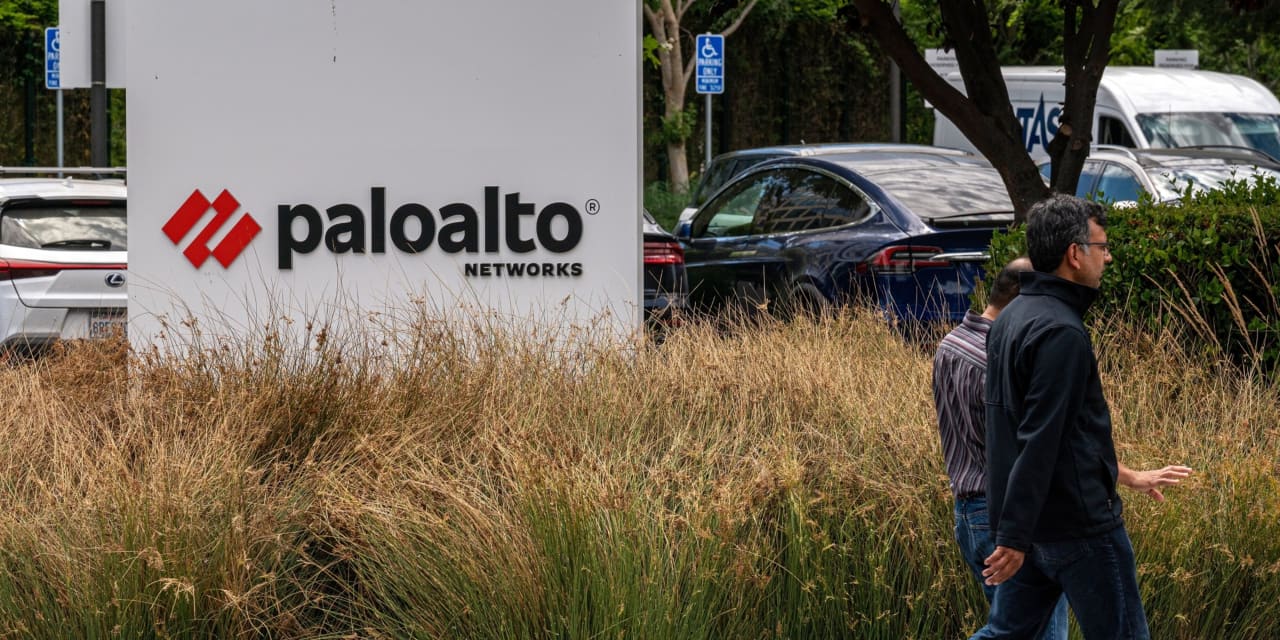This week in the tech sector, upbeat news from
Nvidia
and the AI sector overshadowed some troubling developments at the security software giant
Palo Alto Networks
a day earlier. But Palo Alto’s alarming comments about the outlook for security spending seem likely to linger in the months ahead.
On Wednesday, Nvidia posted the latest in a series of spectacular earnings reports, with revenue more than tripling year over year, spurring a buying spree in shares of every company even remotely connected with AI, and driving the Nasdaq Composite up 3%.
But let’s not forget what happened just one day earlier.
Palo Alto Networks, arguably the leading player in the cybersecurity software sector, unveiled quarterly results and forward guidance that left tech investors terrified. Palo Alto Networks shares plunged 28%, vaporizing almost $34 billion in market value. Other security stocks, like
SentinelOne,
Fortinet,
CrowdStrike,
Zscaler
and
CrowdStrike,
all suffered substantial losses as well.
There were a few issues with the Palo Alto Networks quarter, including unexpected weakness from the government sector. But the real issue involved comments made on the company’s quarterly call that left investors and analysts anxious and more than a little confused.
The company raised issues about a potential slowdown in the growth in security software spending—and unveiled a new strategy to gather more customers than carries some complicated and real costs.
“We’re beginning to notice customers are facing spending fatigue in cybersecurity,” Palo Alto Networks CEO Nikesh Arora said on the company’s conference call. “This is new, as adding incremental point products is not necessarily driving a better security outcome for them. This is driving a greater focus on ROI and total cost of ownership amongst most customers.”
So already there’s a problem. And then he made it worse.
“Our customers are sitting down and saying, ‘If I spend more money, can you show me how I get a lower total cost of ownership across my enterprise? How do I spend less on the services that I have to deploy? And how do I get better ROI?’ So I think it’s more about optimizing their current cybersecurity budgets as opposed to there being no demand,” he said. “Demand continues to be very strong. The customers are demanding to get more for the amount of money they have allocated to cybersecurity.”
Software investors will find the reference to “optimizing” spending both familiar and chilling. For the last two years, cloud-computing companies have been warning that a customer focus on optimizing cloud spending was slowing their growth. Growth at Amazon Web Services, for instance, slowed for six straight quarters, from 39.5% in the December 2021 quarter to 12.3% in the September 2023 quarter, before a recent modest uptick. A similar pattern unfolded at Microsoft Azure.
Meanwhile, Palo Alto Networks said that it was a making a new push on what it called “platformization,” which is a horrible piece of jargon that basically means expanding its software offerings to include more services for customers.
The idea is to drive out “best of breed” point players—to expand the company’s share of the CIO’s security software spending wallet. But the company also said that to do that, it would allow customers to switch over from competitive products without charging them for the period covered by existing contracts. It would be like switching apartments, and having your new landlord charge no rent until your old lease was completed.
The theory is that multi-product customers tend to be stickier—so the company is willing to take an upfront hit in exchange for potential long-term gain. “We want to march faster to our aspiration to become the
Salesforce,
to become the
ServiceNow
or the Workday of cybersecurity,” Arora said. But there will be short-term financial consequences, and potential for increasing price competition.
Guggenheim Partners analyst John DiFucci wrote in an analyst note that Palo Alto’s strategy is to “forgo early revenue…as customers wean off existing products” that Palo Alto itself will replace.
The company said there would be a negative impact to revenue over the next 12 to 18 months, with an eventual return to mid-to-high double digit revenue growth. “Why does PANW have to do this when other companies embark on similar paths of consolidation without having to give away product for a time?” DiFucci asks. “The plan is logical on some level, but many questions surface about whether this is really needed and why now? Given the time frame required, it certainly increases the risk associated with it.” DiFucci keeps his Neutral rating on the stock.
Citi analyst Fatima Boolani kept her Buy rating on the stock, but cautions that the “platformization” push will “wreak havoc on reported billings,” and will keep “investor heat and skepticism high.”
In effect, the company is betting the ranch here that it can seize more of the cybersecurity market, and become the dominant player—and it is willing to give up some near-term economics to get there. It’s a bold bet, but one with considerable risks. And if it works, there could be collateral damage throughout the security software sector.
Write to Eric J. Savitz at [email protected]
Read the full article here




